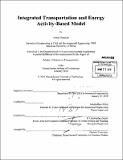| dc.contributor.advisor | Moshe Ben-Akiva and P. Christopher Zegras. | en_US |
| dc.contributor.author | Ghauche, Anwar | en_US |
| dc.contributor.other | Massachusetts Institute of Technology. Dept. of Civil and Environmental Engineering. | en_US |
| dc.date.accessioned | 2010-09-02T14:56:23Z | |
| dc.date.available | 2010-09-02T14:56:23Z | |
| dc.date.copyright | 2010 | en_US |
| dc.date.issued | 2010 | en_US |
| dc.identifier.uri | http://hdl.handle.net/1721.1/58185 | |
| dc.description | Thesis (S.M.)--Massachusetts Institute of Technology, Dept. of Civil and Environmental Engineering, 2010. | en_US |
| dc.description | Cataloged from PDF version of thesis. | en_US |
| dc.description | Includes bibliographical references (p. 130-141). | en_US |
| dc.description.abstract | There is a long history of projects and regulations that have had limited or even counterproductive results. These unforeseen effects are due to the failure of planners to capture all of the complexity inherent in urban dynamics. With the increasing risks of global warming, policymakers and planners need to make optimal or close-to-optimal decisions on how to use the available resources in order to reduce energy and fuel consumption. This thesis develops the framework for an urban model that serves as a decision support tool to inform sustainable policies and investments. The model discussed integrates the modeling of land use, transportation, and energy consumption by micro-simulating the behavior of households and firms in an urban area. This approach derives transport and energy consumption from human activities and includes the two-way feedback between each agent's behavior and the area's overall dynamics. We build upon complex systems theory and make an analogy with epidemiology modeling to derive the properties of heterogeneity-based, organized complex systems. We then translate the properties of these models with respect to the spatial and temporal resolutions of transportation, land market and energy systems' models. To achieve the integration of the three complex systems with activities in our framework, we present three different extensions to activity-based modeling in the household context. | en_US |
| dc.description.abstract | (cont.) We first expand the scope of activities considered in activity-based modeling to fit the integrated transportation and energy scope. We then present the econometric techniques of latent variable and latent class modeling to capture individual heterogeneity. Third, we formulate the motivation behind activity participation and model the short- and long-term activity dynamics by operationalizing the concept of stress. We illustrate the potential of iTEAM in modeling different scenarios to demonstrate the role of our integrated transportation and energy model as a decision support tool for sustainable urban planning. | en_US |
| dc.description.statementofresponsibility | by Anwar Ghauche. | en_US |
| dc.format.extent | 141 p. | en_US |
| dc.language.iso | eng | en_US |
| dc.publisher | Massachusetts Institute of Technology | en_US |
| dc.rights | M.I.T. theses are protected by
copyright. They may be viewed from this source for any purpose, but
reproduction or distribution in any format is prohibited without written
permission. See provided URL for inquiries about permission. | en_US |
| dc.rights.uri | http://dspace.mit.edu/handle/1721.1/7582 | en_US |
| dc.subject | Civil and Environmental Engineering. | en_US |
| dc.title | Integrated transportation and energy activity-based model | en_US |
| dc.type | Thesis | en_US |
| dc.description.degree | S.M. | en_US |
| dc.contributor.department | Massachusetts Institute of Technology. Department of Civil and Environmental Engineering | |
| dc.identifier.oclc | 639577035 | en_US |
